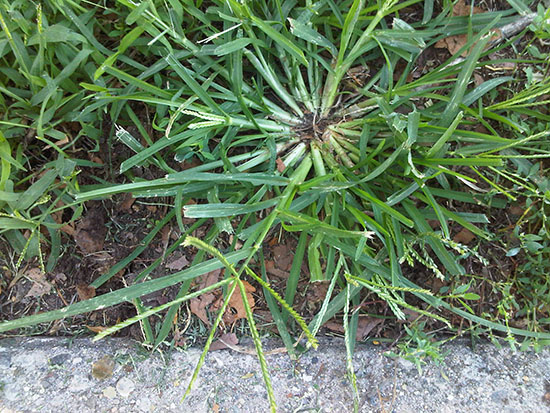Issue 11, July 16, 2018
Goosegrass Gone Wild!
Timely, abundant rains combined with heat and humidity have contributed to the abundance of warm-season annual grassy weeds that we are seeing in Illinois lawns and landscapes. One particular grass that has benefitted from these growing conditions is Goosegrass (Eleusine indica). Recently I attended the Midwest Regional Turf Foundation Field Day at Purdue and the comment was made that it was like goosegrass had gone wild this year. This comical note made me think that perhaps it is a good time to reacquaint ourselves with this "wild" weed.
Goosegrass is a good indicator of compacted soils. We typically find goosegrass in heavily trafficked areas. It does well in poorly drained conditions and prefers full sun.
The stems form a prostrate rosette with a silver or light-colored base. In fact, some refer to this grass as silver crabgrass. When not mowed, goosegrass can grow upright to two feet. The stems are smooth and flattened as the leaves are folded in the bud. The collar is broad and sparsely hairy. The leaves are dark green and up to 1/3 inch wide and 12 inches long. They are usually smooth and folded along midvein. The margins are rough. The ligule is membranous, unevenly toothed, cleft in the center and very short at less than 1/25 inch.

Goosegrass.
Goosegrass flowers appear in July to September. They occur as 2 to 10 fingerlike spikes. Each spikelet resembles a zipper, with two rows of seeds. The roots are fibrous. Germination is generally about two to three weeks after that of crabgrass.
Some look-alike species include orchardgrass, which has a much larger ligule (up to 2/5 in.) and often a more upright growth habit. Crabgrass has a similar growth habit but the leaves are rolled in the bud, not folded (round stems, not flattened).
Appearance in turf often indicates the need for aeration. Attention should be paid to cultural practices and improving turf density. In landscape beds, mulch can be used to prevent goosegrass germination. Existing plants can be removed by hand. Preventing seed production is key. In the spring, preemergent herbicides can be used. Oxadiazon is commonly used for goosegrass, but many are labeled for this weed. Postemergent herbicides for cool season turfgrass include: fenoxaprop, fluazifop, mesotrione, sulfentrazone, topramezone and MSMA (golf courses and sod farms only). More than one application may be needed on goosegrass that has tillered. For landscape beds, herbicides that are specific to killing grassy weeds such as fenoxaprop, fluazifop, and sethoxydim are recommended.
Be sure to read and follow all label directions. Products may be labeled for use on specific types of turfgrass or for certain areas only. (Michelle Wiesbrook)
Author:
Michelle Wiesbrook